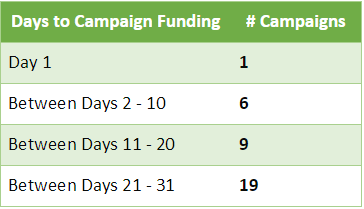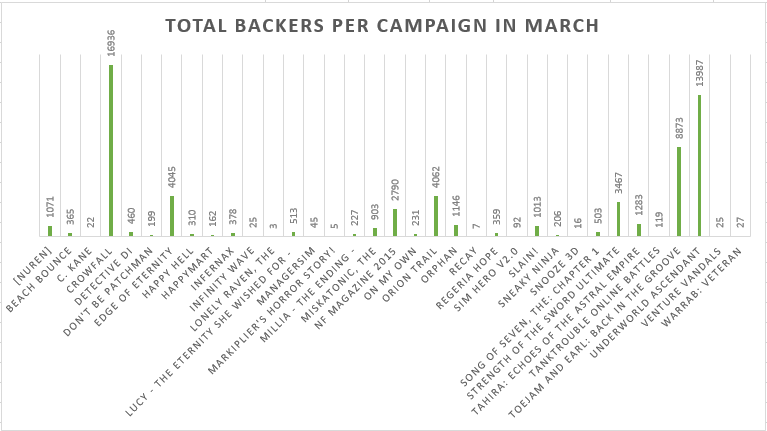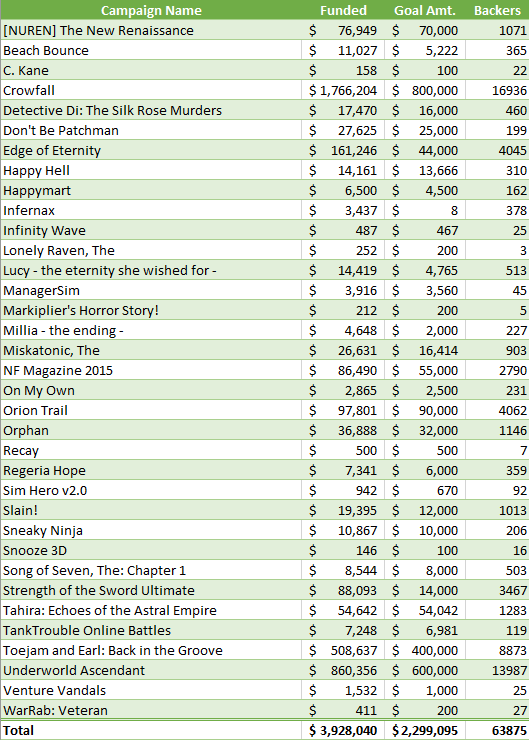Note: All non-US $ amounts have been converted to dollars based on exchange rates as of this writing.
So, how much money was made for video games on Kickstarter in March? Nearly 4 million dollars. Seriously, there was $3,928,040 funneled into these 35 projects. Just in case you’re curious, February saw total funding closer to $2.5 million. If you total up all the goal amounts that people had set, it ends up around $2,299,095. It seems that actual funding blew this out of the water! Of course, not every campaign saw a good ratio of actual funding to goal, but a few did, which makes the goal value so impressively large. The actual average of funding per campaign breaks down to $112,230. But that’s still a pretty excellent number, right?
It is. However, a few choice campaigns always skew this average, inflating it. One only needs to look at the star of March – Crowfall. This one campaign raised $1,766,204 itself, which is a large chunk of the total funding values and in fact the only project which raised over a million this month. Underworld Ascendant came close at $860,356, though! By simply removing Crowfall from the equation, the month’s average drops down to $63,583. There are still a few high funders for the month (three others raised above $100k) but really it’s only statistical anomalies such as million dollar campaigns which require removal for a better assessment.
There’s a similar story to be told of the average goal amount which is $65,688. As mirrors actual funding, only three campaigns asked for $100k or more while most asked for far less. In this case we must remove the three to get a more accurate average. The value drops down to $15,597 which is amazingly close to February’s average goal of $15,380. What does this mean? Unless you are 100% assured your campaign is destined for success (thanks to a known property, super slick presentation, etc) folks should not generally ask for a ton over $15k. This is hard news, as games easily cost far more to make than this, but there is a continued skewed perception of how much games cost thanks to many successful, underpriced campaigns.
Here’s something both backers and project creators are often curious about: How long does it typically take campaigns to actually succeed? All of us probably remember how exciting it is when huge campaigns reach their goal within the first 24 hours. It’s a monumental event, and the kind that I still keep close to my heart. Unfortunately, the reality is very few campaigns ever attain such breakout success. This month’s lone campaign of this type is Infernax, which you may recall only asked for $10. Instead, the majority of backers and creators must stress over watching their run slowly trend toward success. As the days wind down it is a truly scary moment to see if a campaign will actually make it or not.
It appears that more and more campaigns are just barely succeeding in the last week, and in fact, last few days. As compared to last month the only section which increased heavily was between days 21 and 31. There were 14 campaigns in this category last time, with 19 there now. This section makes up 54% of all 35 campaigns for March. What isn’t shown on this chart is just how many barely made it. 11 campaigns were funded in their final three days! I find myself stressing over these late-campaign wins every time, and know that the actual creators much feel even more weight on their shoulders. The biggest issue with late wins is that it leaves far less room for stretch goals, meaning most should not rely on those to implement features they feel are integral to a game.
So, nearly $4 million funneled into Kickstarter in March. But that money doesn’t just come out of nowhere – it’s all thanks to backers. As such, they deserve a look-over as well. As you can see in the bar chart above there were a huge sum of backers funding projects this month. In total there were 63875 of them (of course, some folks may back multiple projects, so the actual number is smaller). Interestingly, this is a lower value than last month’s total of 66485 backers. If you look at average backers it ends up at 1825. Two campaigns received the backing of over 10,000 individuals but the rest could hardly reach as much. Knocking both out drops the average backer count down to 999. That still doesn’t sound particularly bad.
Of course, one has to hope that backers actually pledge a decent chunk of change. For March the average backer value is estimated at $41.72. The number is smaller than February’s $55. Please note that these values are not literal and instead are calculated by total funding/number of backers per campaign. A few campaigns saw suspiciously large average backer values – Crowfall at $104 and Don’t Be Patchman at $138. Crowfall makes sense if you look at it because there were definitely folks making high value pledges. As for the latter, it’s impossible to say, but likely has to do with some friends and family pledging to push that toward success. With both these removed the average backer pledge drops only a few bucks to $36. Project managers should consider multiple tiers around the $30s (at minimum one below, one above, and one right in here).
There is always more information to generate from Kickstarter video game campaign data, but these are just the most notable tidbits to us. If you’d like to know something else (more specific to one campaign, or other stats) then please let us know in the comments or even our forums. We look forward to continue sharing monthly wrap ups throughout the year!
Here’s a look at each successful campaign in a handy table to see where our information came from:







